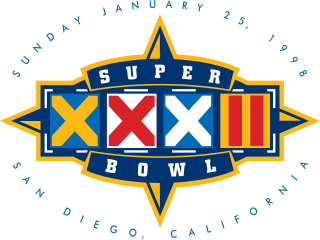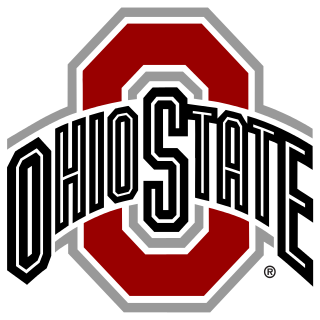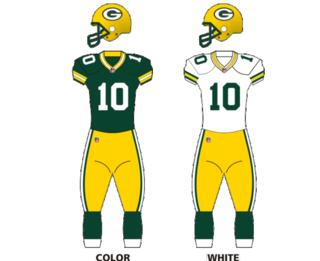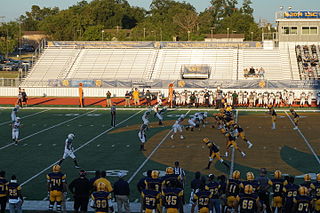
Super Bowl XXXII was an American football game played between the National Football Conference (NFC) champion and defending Super Bowl XXXI champion Green Bay Packers and the American Football Conference (AFC) champion Denver Broncos to decide the National Football League (NFL) champion for the 1997 season. The Broncos defeated the Packers by the score of 31–24. The game was played on January 25, 1998, at Qualcomm Stadium in San Diego, California, the second time that the Super Bowl was held in that city. Super Bowl XXXII also made Qualcomm Stadium the only stadium in history to host both the Super Bowl and the World Series in the same year.
Strategy forms a major part of American football.

Gameplay in American football consists of a series of downs, individual plays of short duration, outside of which the ball is dead or not in play. These can be plays from scrimmage – passes, runs, punts or field goal attempts – or free kicks such as kickoffs and fair catch kicks. Substitutions can be made between downs, which allows for a great deal of specialization as coaches choose the players best suited for each particular situation. During a play, each team should have no more than 11 players on the field, and each of them has specific tasks assigned for that specific play.
The National Football League playoffs for the 1991 season began on December 28, 1991. The postseason tournament concluded with the Washington Redskins defeating the Buffalo Bills in Super Bowl XXVI, 37–24, on January 26, 1992, at the Hubert H. Humphrey Metrodome in Minneapolis, Minnesota.
A trick play, also known as a gadget play, gimmick play or trickeration, is a play in gridiron football that uses deception and unorthodox tactics to fool the opposing team. A trick play is often risky, offering the potential for a large gain or a touchdown if it is successful, but with the chance of a significant loss of yards or a turnover if not. Trick plays are rarely used not only because of the riskiness, but also to maintain the element of surprise for when they are used.

A halfback (HB) is an offensive position in American football, whose duties involve lining up in the offensive backfield and carrying the ball on most rushing plays, i.e. a running back. When the principal ball carrier lines up deep in the backfield, and especially when that player is placed behind another player (usually a blocking back), as in the I formation, that player is instead referred to as a tailback (TB).

In American football, the specific role that a player takes on the field is referred to as their "position". Under the modern rules of American football, both teams are allowed 11 players on the field at one time and have "unlimited free substitutions", meaning that they may change any number of players during any "dead ball" situation. This has resulted in the development of three task-specific "platoons" of players within any single team: the offense, the defense, and the so-called 'special teams'. Within these three separate "platoons", various positions exist depending on the jobs that the players are doing.

The 2006 Ohio State Buckeyes football team represented Ohio State University in the 2006 NCAA Division I FBS football season. The team's head coach was Jim Tressel. The Buckeyes played their home games in Ohio Stadium. The team finished the season with a win–loss record of 12–1, having been defeated by Florida in its final game, the BCS Championship game, and ended the year ranked second.

In American football, a nickel defense is any defensive alignment that uses five defensive backs, of whom the fifth is known as a nickelback. The original and most common form of the nickel defense features four down linemen and two linebackers. Because the traditional 4–2 form preserves the defense's ability to stop an opponent's running game, it has remained more popular than its variants, to the extent that even when another formation technically falls within the "nickel" definition, coaches and analysts will refer to it by a more specific designation that conveys more information with equal or greater conciseness.

Zone coverage is a defense scheme in gridiron football used to protect against the pass.
The 2007 Sheraton Hawaii Bowl was a post-season college football bowl game between the Boise State University Broncos from the Western Athletic Conference (WAC) and the East Carolina University Pirates from Conference USA (C-USA). This sixth edition of the Hawaii Bowl, sponsored by Sheraton Hotels and Resorts, was played at Aloha Stadium in Honolulu on December 23, 2007. The game was the final competition of the 2007 football season for each team and resulted in a 41–38 East Carolina victory, even though sportsbooks favored Boise State to win by 10+1⁄2 points. Many experts believed East Carolina to be big underdogs to Boise State, which had defeated the Oklahoma Sooners in the 2007 Fiesta Bowl. The 2007 Hawaiʻi Bowl paid $750,000 to each team's conference in exchange for their participation.
The following terms are used in American football, both conventional and indoor. Some of these terms are also in use in Canadian football; for a list of terms unique to that code, see Glossary of Canadian football.

The 2009 Green Bay Packers season was the team's 91st season overall and their 89th in the National Football League (NFL). The Packers finished with an 11–5 record but lost in the wild card round of the playoffs to the Arizona Cardinals 45–51. They scored a then franchise record 461 points besting the 1996 Super Bowl team's 456. Charles Woodson was named Defensive Player of the Year for the season, leading the league with 9 interceptions. The defense ranked 1st in the league against the run.

In gridiron football, a penalty is a sanction assessed against a team for a violation of the rules, called a foul. Officials initially signal penalties by tossing a bright yellow colored penalty flag onto the field toward or at the spot of a foul.

In American football, the dime defense is a defensive alignment that uses six defensive backs. It is usually employed in obvious passing situations. The formation usually consists of six defensive backs, usually two safeties, and four cornerbacks, and has either four down linemen and one linebacker, or three down linemen and two linebackers. This formation is used to prevent the offense from completing a medium- to long-range pass play. This may be because the offense's running game is inefficient, time is an issue, or they need a long pass for a first down. It is also used against teams whose pass-to-run ratio predominantly favors pass. The formation, however, is vulnerable to running plays as the formation is missing two linebackers, or a linebacker and a down lineman.

The 2012 season was the Denver Broncos' 43rd in the National Football League (NFL), their 53rd overall and their second under head coach John Fox. The offseason was marked by the signing of former Indianapolis Colts' quarterback Peyton Manning on March 20, leading to the team trading incumbent quarterback Tim Tebow to the New York Jets. The Broncos did not have a first-round selection in the 2012 NFL Draft, and selected defensive end Derek Wolfe as the team's first pick in the second round of the draft.

The 2013 season was the Denver Broncos' 44th in the National Football League (NFL) and their 54th overall. It also marked their 30th season under the ownership of Pat Bowlen, the second with Peyton Manning as the team's starting quarterback and the third under head coach John Fox.

The 2015 Denver Broncos season was the franchise's 46th season in the National Football League (NFL) and the 56th overall. It was also the fourth season with Peyton Manning as the team's starting quarterback, as well as the final season of Manning's 18-year NFL career.

The 2018 Denver Broncos season was the franchise's 49th season in the National Football League and their 59th overall.










